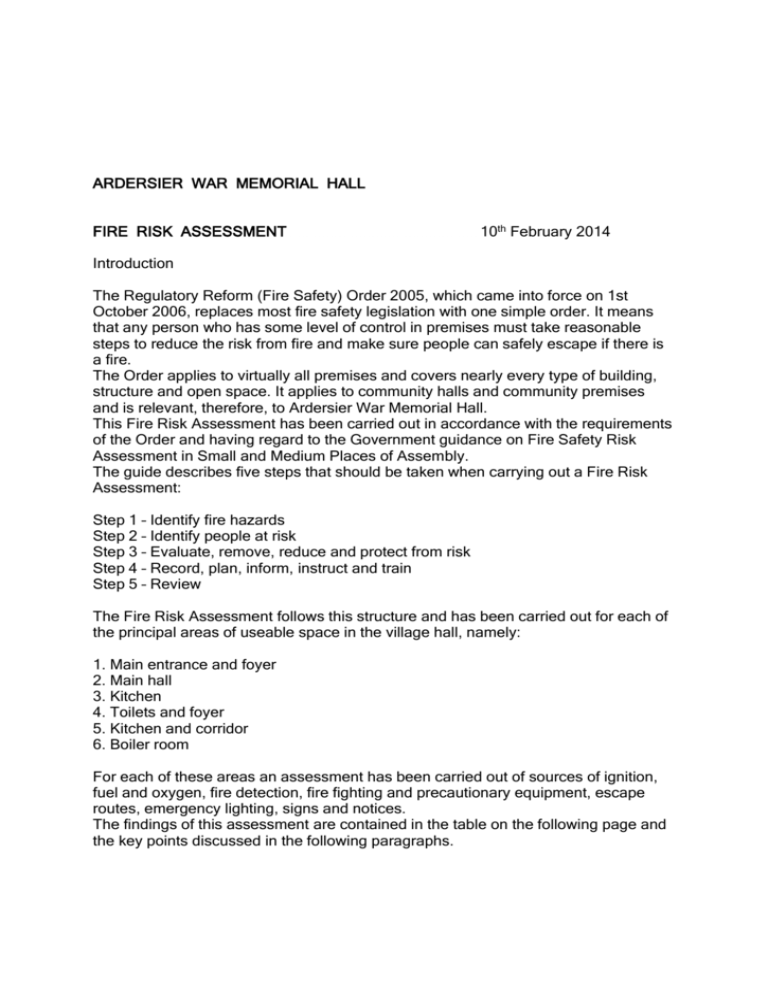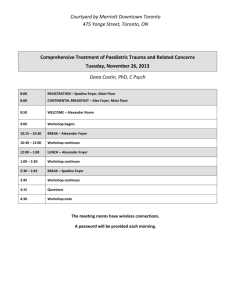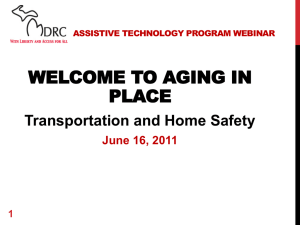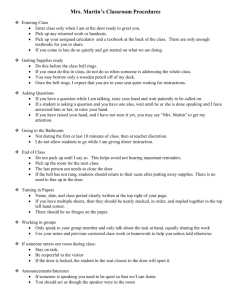Fire risk assessment
advertisement

ARDERSIER WAR MEMORIAL HALL FIRE RISK ASSESSMENT 10th February 2014 Introduction The Regulatory Reform (Fire Safety) Order 2005, which came into force on 1st October 2006, replaces most fire safety legislation with one simple order. It means that any person who has some level of control in premises must take reasonable steps to reduce the risk from fire and make sure people can safely escape if there is a fire. The Order applies to virtually all premises and covers nearly every type of building, structure and open space. It applies to community halls and community premises and is relevant, therefore, to Ardersier War Memorial Hall. This Fire Risk Assessment has been carried out in accordance with the requirements of the Order and having regard to the Government guidance on Fire Safety Risk Assessment in Small and Medium Places of Assembly. The guide describes five steps that should be taken when carrying out a Fire Risk Assessment: Step 1 – Identify fire hazards Step 2 – Identify people at risk Step 3 – Evaluate, remove, reduce and protect from risk Step 4 – Record, plan, inform, instruct and train Step 5 – Review The Fire Risk Assessment follows this structure and has been carried out for each of the principal areas of useable space in the village hall, namely: 1. Main entrance and foyer 2. Main hall 3. Kitchen 4. Toilets and foyer 5. Kitchen and corridor 6. Boiler room For each of these areas an assessment has been carried out of sources of ignition, fuel and oxygen, fire detection, fire fighting and precautionary equipment, escape routes, emergency lighting, signs and notices. The findings of this assessment are contained in the table on the following page and the key points discussed in the following paragraphs. Step 1 – Fire Hazards: Sources of Ignition, Fuel and Oxygen The main sources of ignition are the water heater in the disabled toilet and the heating boiler in the kitchen corridor. Elsewhere, the main sources of ignition are electric sockets and lighting located throughout the hall areas. Elsewhere, the main sources of fuel are tables and chairs. The main source of oxygen is the natural airflow through, doors, windows and other openings. This natural airflow is sometimes supplemented by mechanical means when our extractor fans in the main hall are used. Step 2: People at Risk People who use the hall and may be at risk if there is a fire include: Hirers The Hall Management Committee Local organisations Contractors Cleaners Visitors Hirers, contractors and visitors who are unfamiliar with the hall layout Children The elderly People with disabilities (mobility, hearing or vision impairment) Step 3: Evaluate, remove, reduce and protect from risk 1. The risk of fire occurring It is considered that the risk of fire is relatively low. There is no electrical supply to the kitchen and foyer. The main sources of ignition comprise an air source heat pump in the boiler room and an electric water heater in the disabled toilet. Combustible materials are kept away from these areas and both pieces of equipment are new as from February 2014. Elsewhere electric sockets and lighting are new and in good order. 2 The risk to people An evaluation has been carried out as to the actual risk to people identified in Step 2 in the event a fire did start and spread from those areas with the main sources of ignition ie the boiler room and disabled toilet. The main entrance/foyer, the main hall, boiler room and disabled toilet are all at ground floor level and are open to the various escape routes available. 3. Removal/reduction of the hazards The identified potential hazards comprise the electrical equipment contained in the boiler room and disabled toilet which are an essential part of the facilities available to the users of the village hall. Heating and hot water are essential for the users of the hall and the potential hazards are reduced as far as possible through regular maintenance, inspection and servicing. The village hall operates a No Smoking policy in all areas of the building. Elsewhere flammable materials are limited to tables and seating, and are kept away from potential hazards. Sports and leisure used in the hall are supplied by the users and do not remain in the hall. 4. Removal/reduction of the risks to people The fire risk to people has been reduced to as low as reasonably practical by ensuring that adequate fire precautions are in place to warn people in the event of fire and to allow them to escape safely. An electrical fire detection system is in place incorporating an alarm bell and manually operated ‘break glass’ points which are located in the main entrance/foyer, in the main hall and in the toilets foyer. Fire extinguishers for particular types of fire are situated in the main entrance/foyer, main hall, toilet foyer, and kitchen corridor.. These are regularly inspected and the Certificate of Inspection is displayed in the main entrance/foyer. There are four main escape routes available at ground floor level and are readily accessible from all parts of the building. All are independent of each other with emergency escape lighting. The main escape routes are (1) via the main entrance (2) via an external fire door off the main hall (3) via the corridor linking the kitchen and boiler room (4) via an external door in the toilet foyer. Escape routes are all unencumbered and are listed in the accompanying table. External fire doors 1,2, and 3 lead to the outside car parking areas that provide open space for safe and easy clearance of the hall. External door 4 is a side exit with easy access to a road. Escape routes and exits together with the locations of fire fighting equipment are indicated by appropriate signs throughout the building as indicated in the accompanying table. Fire exit signs are included on the emergency lighting panels throughout the hall are also detailed in the accompanying table. Notices indicating the location of fire doors and extinguishers are situated in a variety of positions around the building. Each fire extinguisher has operating instructions clearly displayed. 5. Installation, testing and maintenance All fire prevention and fire fighting equipment is maintained in effective working order through regular checks, periodic servicing and maintenance. Sources of risk are also checked on a regular basis. A log of all checks and servicing and maintenance is kept. Weekly checks are made of water heater, emergency lighting, fire doors, lights, heating boiler and the fire alarm. An annual check is made of the fire extinguishers, and a certificate of inspection obtained. The electrical system is also checked on an annual basis and a safety certificate obtained. Conditions of Hire The conditions of hire of the village hall state that fire and other exits must not be obstructed and that illuminated fire exit signs must be on for all public entertainment. The conditions of hire are shown on the Village Hall website, www.ardersier.org. For theatrical and entertainment events particular health and safety procedures apply and an appointed person is responsible for fire safety and emergency evacuation. Step 4 Record, Plan, Inform, Instruct and Train 1. Significant findings and action taken The main findings of the fire risk assessment including the actions taken to prevent fire occurring and to reduce the risk to people are contained in the preceding sections of this report. A plan showing the general fire safety is included. 2. Emergency plan The village hall has a relatively simple layout with clear and well signed escape routes. As explained above, the conditions of hire state that fire and other exits must not be obstructed and that illuminated fire exit signs must be on for all public entertainment. The village hall operates particular health and safety procedures for theatrical and entertainment events covering the appointment of a health and safety officer, preparation for public entry to the event, emergency procedure, performance restrictions, no smoking and notification to the public. 3. Information and instruction Copies of the Conditions of Hire and the conditions relating to Theatrical and Entertainment Events are provided to hirers who are required to accept and adhere to them. Signs indicating the location of fire doors and fire extinguishers are posted at various prominent and visible points throughout the hall. Fire safety advice is given to the hall cleaners and contractors. Step 5 Review This fire risk assessment has been carried out for the village hall following the introduction of the Regulatory Reform (Fire Safety) Order 2005. The assessment is kept under review particularly with regard to any potential new risks and the need to keep them under control, and also to ensure that the fire precautions are still working effectively. Location Sources of ignition, fuel and oxygen Fire detection fire fighting and precautionary equipment Escape routes Main entrance and foyer Electric sockets and lighting. Fire alarm point CO2 extinguisher Water extinguisher Main hall Electric sockets and lighting. Ventilation fan switches Fire alarm point One water extinguisher Emergency lighting, signs and notices Via main door Emergency lighting No smoking sign Location of fire door and extinguisher sign Via external fire door to car park. Via main entrance. Via toilet foyer external door to street. Emergency lighting Above external door, above door to main Entrance, above door to toilet foyer. Emergency lighting Above external door, Toilet Foyer Electric Fire alarm point sockets and CO2 extinguisher Lighting. Water extinguisher Heating manifold control. Via external fire door to street. Via main entrance. Toilets Electric lights None Via external fire door to street. Emergency lighting Above external door. Disabled Toilet Electric light Electric water Heater. None Via external fire door to street. Emergency lighting Above external door. Boiler Room Electric switches. Heating boiler Fire alarm point Via external fire Door to car park Emergency lighting above external door. .






